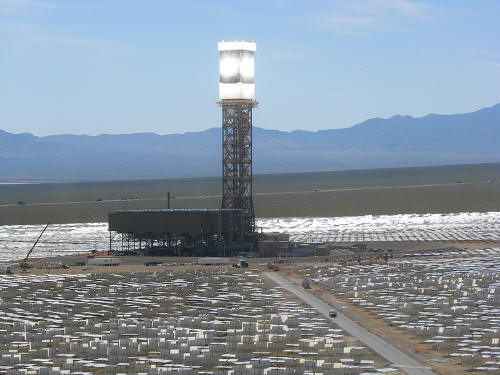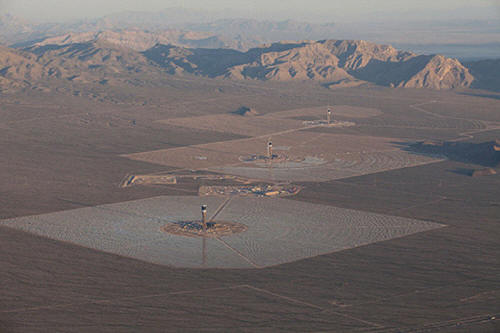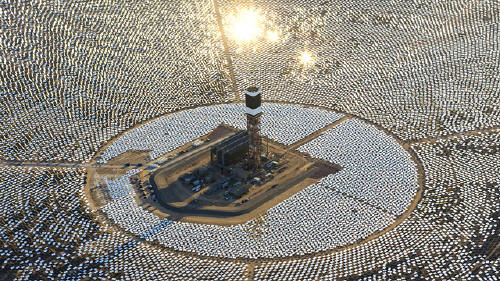
Hyperstealth's "Declipse™" Shadow Reduction Technology Solves MIT Roadblock towards Terawatt-Scale Solar Power Generation
(February 25, 2014, Vancouver, B.C.) Hyperstealth Biotechnology Corp. President/CEO, Guy Cramer, announces another new technology they've called "Declipse" where shadows can be reduced to enhance Solar Power output. A Solar eclipse of the Sun by the moon will cast a shadow on the earth, turning day into night. Declipse as the name implies has the opposite effect reducing shadows thereby increasing output for Solar Panels.
A new Solar Panel configuration developed by MIT researchers that goes up vertically in a tower format they have called three-dimensional photovoltaic (3DPV) structures, promises the potential for terawatt power generation producing from 2-20 times the output of a flat solar panel taking up the same footprint - the only issue standing in the way is one crucial item; The shadows from the 3DPV towers will decreases the power output of the neighboring 3DPV tower by so much that any large scale application of this new technology where multiple towers are required side by side will not be profitable.
By combining Hyperstealth's Declipse technology with multiple 3DPV Solar Panel towers (3DPV Farms), the assessment by MIT researchers of the real possibility of Terawatt Generation may now be achievable.
Shadows are the Kryptonite of the Solar Energy Industry
Many people do not know that even a slight shadow on a Solar Panel can reduce power output by over 90%, while this is well known in the solar panel industry, it means that many locations which might appear to be good locations for Solar Panels will actually suffer from extreme power loss during the times of the day and/or seasons when shadows cross the panels.
Flat Panel Solar Farms can be stationary but only achieve maximum output for a few hours each day, whereas flat solar panels which track the sun throughout the day (pointing the panel directly toward the sun as it moves through the sky for maximum power output) also needs to be offset from their neighboring panels so no shadows from the other panels interferes with their direct sunlight.
|
“Our findings suggest that harnessing solar energy in three dimensions can open new avenues towards Terawatt-scale generation,” the MIT authors write in the abstract of their article, ”Solar Energy Generation in Three Dimensions”, published online by the journal Energy & Environmental Science http://dspace.mit.edu/handle/1721.1/81273
Solar Power has never achieved the large market share that scientist envisioned.
Solar energy share of global energy consumption 0.7% Germany is leading the way: Germany leads the world in Solar Power Generation setting a record in 2012 providing 22 gigawatts of electricity per hour - equal to 20 nuclear power stations at full capacity. That record has increased in the summer of 2013 to 23.9 gigawatts. The country requires 60 Gigawatts per hour so this is a large portion of Germany's requirement but it only occurs in the summer when the sun is at the seasonal apex. Germany decided to pull the plug on Nuclear Power after the Japanese Fukushima nuclear disaster, closing eight plants immediately and shutting down the remaining nine by 2022. http://www.reuters.com/article/2012/05/26/us-climate-germany-solar-idUSBRE84P0FI20120526 As of 2012 The Global Solar PV (Photovoltaic) installed capacity was 69 Gigawatts. http://www.c2es.org/technology/factsheet/solar#_ednref37 We are still far from the Terawatt - scale generation that MIT researchers envision as 1000 Gigawatts = 1 Terawatt |
Using Hyperstealth's Declipse technology, these tower shadows will now only have a minimal impact on power output if their shadow crosses a neighboring tower, this means that the towers may be placed close together and replace the lower output flat panel solar farms. The MIT 3DPV Solar Towers also do not need to track the sun to achieve their maximum potential.
 The report is published in Energy and Environmental Science, which states
that the designs can add 2 to 20 times the power density per area. Note this
is not by volume
and since towers close together would shade one another,
this is primarily a design for urban environments and not open fields.
http://inhabitat.com/mit-unveils-3d-solar-arrays-that-produce-up-to-20-times-more-energy/ The report is published in Energy and Environmental Science, which states
that the designs can add 2 to 20 times the power density per area. Note this
is not by volume
and since towers close together would shade one another,
this is primarily a design for urban environments and not open fields.
http://inhabitat.com/mit-unveils-3d-solar-arrays-that-produce-up-to-20-times-more-energy/
Ultra-Efficient Solar Power Doubling the efficiency of solar devices would completely change the economics of renewable energy. MIT Technology Review http://www.technologyreview.com/featuredstory/513671/ultra-efficient-solar-power/ Fig. 1 (a) 3DPV structures made using Si solar cells with area 3 x 3 cm2. From left to right, an open cube (1), an open parallelepiped twice as tall (2), and a tower (3). The structures are made up, respectively, of 9, 17, and 32 solar cells. (b) Power generated by a flat Si panel at various tilt angles measured under simulated solar light illumination, and comparison with computer simulation. The error bars in the simulation results derive from a range in the assumed efficiency of +/1%. (c) Both measured and simulated power during a single sunny day for the open cube and for a flat panel of the same base area, showing a maximal range of hours of constant power generation and nearly twice the energy density output for the 3DPV case compared to the flat panel. (d) Energy generated by the structures shown in (a) under different weather conditions, expressed as a ratio to the energy generated by a flat panel under the same weather conditions. Comparison of the black and blue bars for the case of the parallelepiped and tower shows how structures of higher aspect ratio than the open cube can further outperform a flat panel on a cloudy day compared to a clear day. The parallelepiped in (a) is referred here as ‘‘tall cube’’. (e) Power generated vs.time for the data of cloudy weather shown in (d). Energy Environ. Sci. T |
Hyperstealth's Thin Film Solar Panel Testing with Declipse:
Cramer has tested with both thin film solar panels, (these are the type of panels used with the MIT 3D Solar Towers). A small shadow crossing only 1/3 of the entire panel on the thin film solar panel reduced power by 90%. Using the simplest application of placing Declipse between the item causing the shadow and the thin film solar panel boosted the output by 600% but the panel was still 40% less power than the control (thin film) panel in direct sunlight. Using a second Declipse panel boosted output by another 200% to 800% over the panel with only the shadow, now the panel is at 80% output of the control panel.
Hyperstealth's Monocrystalline Silicon Solar Cell testing with Declipse:
Monocrystalline Silicon Solar Cells are more efficient (they are able to utilize more of the solar energy than the thin film panels) but they are also more expensive. Typically these are the ones used for wider scale applications such as those used for many homes and businesses.
The same shadow on the larger Monocrystalline Silicon Solar panel covering 25% of the panel reduced power by 92+% (which is only 7.63% output).Using Declipse in-between the item causing the shadow and the solar panel boosted the output by 822%, it is still at 62% of the output of the control panel without any shadow. Utilizing a second piece of Declipse boosted the output by another 21% to 83% output and a third piece surpassed the 100% mark. In essence the shadow at this point has no detectable effect on the solar panel and we've surpassed the power output of the identical solar panel in direct sunlight without the Declipse and without the shadow.
The reason that MIT used the Thin Film Panels and not the more efficient Monocrystalline Silicone Solar Cells is that the thin film works better in lower light conditions and due to the angles of the panels many of the panels that are not directed right at the sun will still generate some power, where the Monocrystalline require direct sunlight to provide adequate power output
 MIT researchers unveiled a new three-dimensional solar array that can produce up to 20 times more energy per square foot than traditional flat arrays- and it’s potentially more efficient than standard arrays as well. The team tested multiple stacked PV panel configurations and settled upon a 3D shape that takes in the most light over time per area of ground. Their remarkable results (especially in cloudy weather) point to a promising way to apply solar panels to tall buildings and other structures without sacrificing space. These new MIT panels were cost effective and worked far better in cloudy and overcast conditions than the existing flat panels, they also produced far more power in the morning and evening hours when the angle of the sun is lower on the horizon without having to track the sun, these are times which hinder output from flat solar panels. The report is published in Energy and Environmental Science, which states that the designs can add 2 to 20 times the power density per area. Note this is not by volume and since towers close together would shade one another, this is primarily a design for urban environments and not open fields. http://pubs.rsc.org/en/content/articlelanding/2012/ee/c2ee21170j#!divAbstract |
What Hyperstealth Declipse has done is not reinvent the solar panel, but solved the one problem which has been keeping this new MIT developed 3DPV technology from achieving the researcher’s expectations. Cramer equates this with the best hockey player in the world playing without a $40.00 hockey stick, if you have ever watched a hockey game where a player loses his stick or breaks his stick, he is unable to play the game and actually becomes a liability without the stick.
A 3DPV Solar Tower farm where these towers would replace flat Solar panel farms without Hyperstealth's Declipse technology would likely result in poor overall power output over the course of a sunny day when compared to the flat panels they replace. With Declipse, the 3DPV towers could be placed in the same footprint as the flat panels and function with a much higher output, even when the shadows were crossing other 3DPV towers.
Are there other Solar Power applications where a Shadow can be reduced with Declipse?
|
The Stadium
for the Seattle Seahawk has the largest Solar Array in the State of Washington:
The 2.5 acre array will cut their energy costs by 21% using a unique tubular solar panel which makes full use of the sun, even when it is overcast. The Solyndra solar panels click into place and capture light from all directions rather than just one which is good news in a place that does not see a lot of direct sunshine.
The tubular construction allows wind to blow right through and helps keep the surface free from dust and snow as well as reduce heat buildup which reduces the efficiency of the solar cells. The array is projected to produce 870,000 kW of energy a year, making it the largest of its kind in Washington State. While at first blush, solar seems like an odd choice for Seattle, the city actually has better resources than Germany, which has the most installed solar. http://inhabitat.com/seattle-seahawks-stadium-boasts-largest-solar-array-in-washington-state/ |
The White roof in the article above is used to reflect the light to the underside of these tubes. They tubes themselves use the thin film solar cell wrapped around the tubes.
Where you see shadows in Solar Energy; Hyperstealth sees power lost which we can now recover.
Placing Declipse under the tubes would allow for a second layer of tubes under the tubes and potentially a third layer under that using the Declipse between the second and third layer. Conservative estimates with three layers should provide a doubling of the power output over one layer and it would still utilize the same footprint.
Solar Thermal Energy
 Mirrors
are used in Solar Thermal Energy systems to reflect sunlight on a central tower
to produce steam to generate power from steam turbines. The Mirrors are placed
in very specific configurations to avoid shadows from surrounding mirrors
Mirrors
are used in Solar Thermal Energy systems to reflect sunlight on a central tower
to produce steam to generate power from steam turbines. The Mirrors are placed
in very specific configurations to avoid shadows from surrounding mirrors
The World’s largest Solar Thermal Farm was just completed in late 2013 and is located in the Mojave Desert. Ivanpah Solar Electric Generating System has 170,000 mirrors each one measuring 70 square feet placed across 3,500 acres to power 140,000 California homes http://ivanpahsolar.com/about
Cost to construct the Ivanpah system was $2.2 Billion Dollars. Using sunlight instead of fossil fuels will reduce Carbon Emissions by more the 400,000 tons annually.
You can see in the photos that the placement of the tracking mirrors needs to be spaced so shadows do not interfere with the neighboring mirrors throughout the day.
What happens when you can place mirrors closer together by using Hyperstealth's Declipse reducing shadows; you either reduce the required footprint (area taken up by mirrors, in the last photo showing 3,500 acres) or you are adding more mirrors with the same area for higher temperatures, which equals greater power output.
Below are photos of the same Ivanpah Solar Electric Generating System at different points in the construction process.
http://phys.org/news/2013-09-ivanpah-solar-california-energy-grid.html
 |
 |
 |
 |
| http://gizmodo.com/the-worlds-largest-solar-plant-started-creating-electr-1521998493?utm_campaign=socialflow_gizmodo_facebook&utm_source=gizmodo_facebook&utm_medium=socialflow | |
Mirror Boosters
After seeing the Photovoltaic Solar Panels and Solar Thermal applications you may be thinking: What about using mirror boosters (directing extra sunlight with angled mirrors) onto Photovoltaic Solar Panels to increase output?
This does increase output on the solar panels (in some cases by 30% more) but it also creates hotspots which tend to overheat the panels and will turn the blue color of the solar cell to a brown color – the manufacturer can tell by this brown color that you attempted to mirror boost. It also can limit the life of the panel to one year and voids your warranty as some Monocrystalline Silicon Solar Cell panels have a 25 year life span.
In the Corporate World; Money = Power, In the Solar Industry; Power = Money
Hyperstealth Shareholders who attended the company's AGM in December of 2013 were shown an extensive presentation on the Hyperstealth Declipse Research and Development conducted by Guy Cramer that had taken place in the fall of 2013.
The Canadian Military was also informed of the results of the testing and is also interested in the Declipse technology due to their use of Solar Power requirements when deployed and off-the-grid. With civilian reliance on personal electronics the next recharge is only a wall socket away, whereas the modern military soldier is even more reliant on their electronic devices but often they just can't go plug in their devices at night to recharge, either the need powerful batteries or a mini power station and Solar Panels do just that.
When dealing with the Sun, there will be obstacles where shadows are involved. In many instances, Hyperstealth's Declipse can improve or overcome the shadow completely. This is only the first round of potential applications of Hyperstealth Declipse technology with three others identified and under R&D (yet to be announced).
Declipse may be one of the key components that jumpstarts the next generation of Solar Power Generation applications that may eventually take over the requirement for nuclear power.
Hyperstealth is awaiting patent pending approval status before announcing the Declipse methodology publicly.
For more Camouflage news go to the HyperStealth® Home Page
HyperStealth is a Registered Trademark of HyperStealth Biotechnology Corp.
Declipse is a Trademark of HyperStealth Biotechnology Corp.
This page is © Copyright 2014,Hyperstealth Biotechnology Corp., All Rights Reserved.